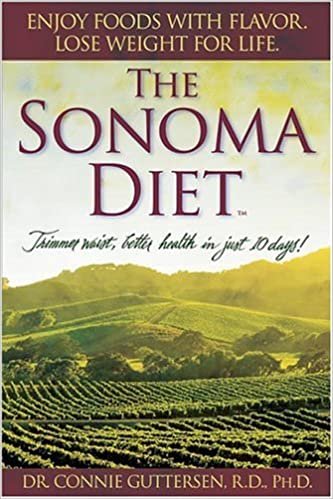Doesn’t the Sonoma diet call for a specific size plate and bowl to be used for meals?
Yes, and there’s reasons for this. First, we know that portion control is really important.
And more recently we’ve discovered that the combination of foods is also important-how much protein, carbs and fat you eat with each meal.
Some books have fancy charts or they make you weigh things to determine this. But I felt that a lot of that was tedious and takes a lot of time and most people don’t want to deal with it.
So I tried to think of something that would be an easy way to control portions and the balance of foods. So I decided to base it on the size of the plate.
First of all, it gets people eating off of a plate instead of from packages! And if you look at the plate size and base your portion on that, it’s easy to understand. We used to have much smaller plates and bowls.
Today, when you talk about a dinner plate it’s more like platter. Well, it’s very hard to keep your portions down when you’re using a platter to feed yourself! I recommend a smaller size: a 9 inch plate for lunch and dinner and a 7 inch plate (or 2-cup bowl) for breakfast.
It’s a little trick that makes it easier to keep the portions down, because you’ll overflow the plate otherwise. At the same time as changing plate size, the Sonoma Diet focuses on the concept of readjusting the balance of the food on that plate.
For example, for lunch and dinner I recommend 25% protein, 25% grains, and 50% vegetables and fruit. It’s easy to divide the plate into sections to visualize the right balance. These combinations will maximize the health benefits of the food, and promote weight loss.
It’s very easy to keep track of portion control by being mindful and aware-but not obsessive. And we’re not trying to starve ourselves. In Wave One, women are eating approximately 1,200 to 1,300 calories and for men it’s 1,500 to 1,600 calories.
And then by Wave Two the women are eating approximately 1,500 calories and the men are eating 1,800 to 2,000 calories. Just by following the menus in the book that are set up, with those combinations on the right size plate, you’re going to lose weight.
So you don’t need to count calories?
No, this is a much simpler method.
Some restaurants serve a small amount of food on a big plate, as a certain presentation style. But it’s much more common to have huge portions, because the restaurants realize that the ingredients are cheap, so they load you up. But if you take home leftovers, then you’ve got lunch the next day.
Maybe so, but most people tend to eat a lot more when they are given a big portion, because you tend to eat what’s in front of you.
Isn’t it much healthier to stop eating when your stomach is only half or two-thirds full?
Yes. If you eat large amounts, it puts a strain on the stomach and the whole digestive system. It’s really hard to eat an overabundance of food when you have a glass of wine and take the time to eat slowly and savor every bite. You really tend to eat less that way.
Many people don’t even chew their food very much.
That’s correct. If you don’t chew your food well, you don’t get all the nutritional benefits. You need to chew more to break up the food to release the nutrients.
Also, if you don’t take the time to chew your food properly, you don’t have enough time for the signals to travel to the brain saying that you’ve had enough to eat.
Your diet seems similar in many ways to the Zone Diet. Are you familiar with the work of Barry Sears?
Yes, there are some similarities. If you were to look at the nutrient allowances, they would come up very similar. I think the difference is I’m a foodie, and I place a huge emphasis on flavor. I want people to get back in the kitchen.
I’m promoting an incredibly tasty, flavorful way of cooking, adapted by our lifestyle. I think I’m easier on the scientific concepts, and I take more of a common sense approach.
The Sonoma Diet does not impose restrictions on the times of meals. Many other diets do, such as not eating after 6:00p.m. Do you think this is unnecessary?
If you’re eating the amounts I’m recommending in The Sonoma Diet, then I don’t see the meal times as a big concern. Here in Napa Valley, sometimes we don’t eat dinner until really late, but we never eat heavy meals. Often our heaviest meal is at lunch.
You also don’t require people to switch from eating three meals a day to five or six, but isn’t there some evidence that smaller meals eaten more frequently make it easier to lose weight by regulating blood sugar and controlling cravings?
I prefer three meals a day plus a snack. Some people consider six small meals a day as the ideal. My main point is not to skip a meal.
Drinking lots of water has been mentioned by many people as an aid to weight loss. Do you agree?
Yes, drinking enough water is very important. When you drink lots of water, you sleep better, you feel better, your skin looks better, and you have more energy to go out and exercise.
Water is a critically important nutrient that people sometimes forget. Many people are dehydrated but don’t recognize it.
Note: There is one more part to this interview, which will be posted soon.

